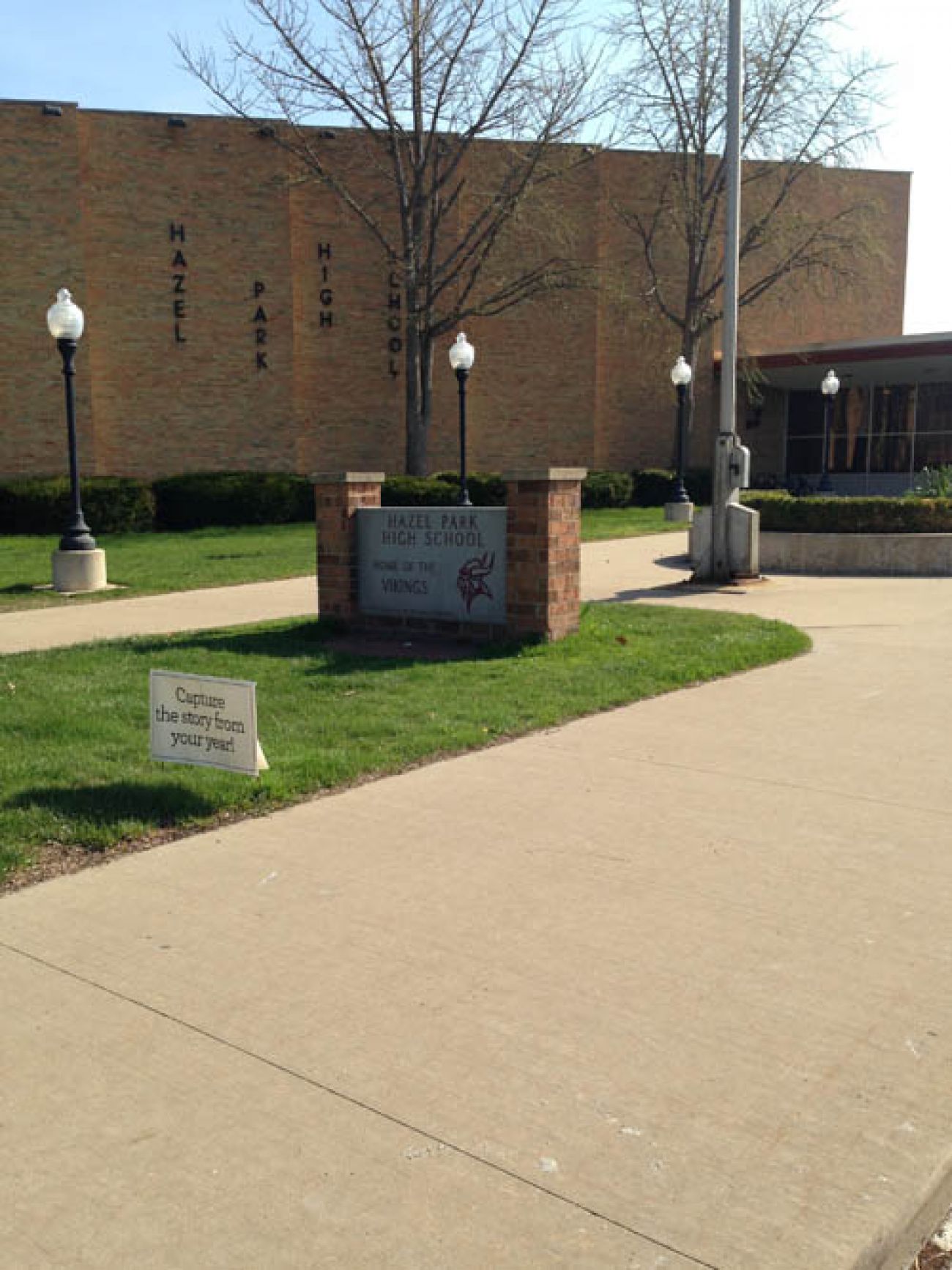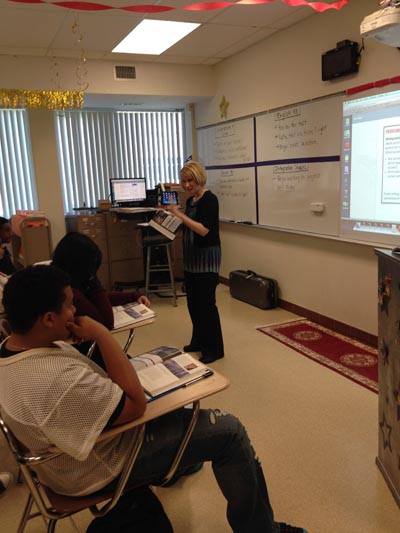One high school’s miracle revival. And what may kill it.

Don Vogt has been principal of Hazel Park High School for 14 years. For most of those years, he came to work each day and, by his own admission, did the minimum amount required. No less, but not much more either. Nobody seemed to complain, no one was expecting more.
And that approach worked fine, until it didn’t.
In 2012, Hazel Park High School was identified as one of the poorest performing high schools in the state of Michigan, putting it at risk of being placed under the control of an emergency manager or even shut down. It was what Vogt called a “swift kick in the gut.”
Brutal enough that Vogt and the majority of his fellow staff members decided this was not how their story would end.
“I’ll be very honest, we weren’t successful for 11 of my 14 years,” Vogt told Bridge. “We just kind of went with the flow; we maintained and tried to keep our head above water.”
With the clock running, and the threat of a school takeover similar to that for struggling schools in Detroit hanging over its head, Hazel Park High created a transformation plan that would elevate student achievement from abysmal to remarkable.
The school’s ACT scores have risen sharply, along with graduation rates. Since 2012, the school went from the bottom 5 percent of public high schools in the state, to ranking among the very best. In 2013-2014, the most recent year for which scores are available, the school had risen to the 85th percentile statewide.
“Here we have a sense of community,” senior class salutatorian Miranda Gavel said of the changes. “Like when we needed to raise ACT scores, we buckled down.”
The results are evidence, Vogt said, of what a little incentivized desperation can do when a school community joins together – parents, teachers, administration, and students – and refuses to fail. The school’s improvement may serve as a lesson, even a blueprint, for education across Michigan, as Gov. Rick Snyder recently assumed more direct control of school turnaround strategy.
After success, catastrophe
But Hazel Park High’s revival may be short-lived. For just as the school reversed its fortunes, the Hazel Park School District began to unravel. By March of this year, the district, which has 14 schools (including 6 adult and alternative schools), announced that it faced a deficit of $6.2 million, which is expected to nearly double by the end of June to $11.8 million.
The district expects to cut 169 workers by July, including 46 teachers. Superintendent James Meisinger resigned on March 9. The curriculum administrator and business manager also resigned. Interim Superintendent Dr. Rick Repicky posted a two-page letter on the Hazel Park Schools website saying the district was trying to fix this “surprise” gap, which he said was more than four times the $2.6 million deficit expected this year.
Talk about a kick in the gut.
“I had to pink slip 15 (high school) teachers on Wednesday,” Vogt said in April, adding that they were newer teachers, many of whom were among the school’s best (The district’s union deal requires the newest teachers be the first to be let go).
[After this article was published, district officials contacted Bridge to say that, contrary to the principal's statements, the district did not lay off the teachers strictly based on seniority; rather, the layoffs were based on a host of factors including performance and relevant training.]
Superintendent Repicky later clarified that “only” 12 teachers at Hazel Park High will be let go, leaving 28 at the school. The district also imposed a 10 percent across-the-board salary cut to address the massive deficit.
The cuts to teachers and finances, Vogt said, “could cut our heart out.”
A long road
To understand what a blow the recent setback could be to Hazel Park High, and why Vogt takes it so personally, consider what the high school managed to accomplish in such a short time, and how it was done.
“It was a very tough school,” Vogt said of the school he inherited 14 years ago. “There were a lot of fights.”
Since his arrival, Hazel Park High has become an open enrollment school, allowing students from outside the city to enroll. Demographically, Hazel Park High breaks down similarly to many high schools in Michigan, with roughly 73 percent identified as white and most of the remaining students as African American with a smaller number of Hispanic and Asian students.
By Vogt’s admission, and that of several teachers, not much was done about the school’s academic performance until the school was notified in 2012 that it was now considered a “priority school”, meaning it was in the lowest-performing 5 percent in the entire state of Michigan. Kathy Kish, who has been a counselor at the high school for 30 years, remembers what her school was like before the turnaround.
“Beforehand, it was like it was business as usual,” she said. “And then when we got hit with that, it was like, ‘OK, we’re all being a little lax here. We really need to get on board and put some things in place and change these scores.’”
Lenore Barshaw, another school counselor who worked at Hazel Park High for several years before it was labeled a failing school and then rejoined the staff for the past two years, agreed.
“Before, you would see students in the halls just roaming,” Barshaw said. “Not going to class. If kids didn’t feel like going to class they didn’t go to class. Now the halls are swept. You are expected to be in class.”
Rebuilding a school
After being labeled a priority school, Michigan’s School Reform Office initially presented the high school with the option of becoming a charter school, shutting the school down, or firing the principal and many of the staff. School leaders strongly opposed all three options, which could have led to the high school being taken over by the Education Achievement Authority. They chose instead to present an aggressive transformation plan for survival.
“The first thing they wanted to do in the plan was they wanted to replace the principal,” said Vogt, the principal. “So I fought it. My feeling was, I got us into this, and I’d like to play somewhat of a part in getting us out.”
“My feeling was, I got us into this, and I’d like to play somewhat of a part in getting us out” ‒ Principal Don Vogt on his school’s drive to improve
A native of St. Louis, Vogt notices everything around him as he makes his rounds throughout the school, chastising some students who don’t appear to be where they should, questioning others, showing glimpses of impatience, but also generously commending those whom he feels have achieved something worthy of recognition.
Vogt said he immediately went to work with his staff and members of the community on a way to save their high school the same way that he walks his hallways, which is fast.
Three steps
The transformational plan he helped devise had three main parts:
Add an ACT prep class to help students perform better on the test.
Create a free or reduced-rate summer school to accommodate the majority of families who would not be able to afford the extra expense. Research shows that low-income students tend to lose more knowledge during the long summer break than students from more affluent families because they have fewer opportunities and resources to stay academically engaged. Students, many of whom were behind on credits, would be given 16 credit hours for summer school attendance.
Adopt flexible scheduling that would allow students to make up class work before school by coming in an hour early and working with a teacher.
All of the recommended changes were approved and went into effect during the 2012-2013 school year. Teachers agreed to an additional 30 minutes being added to the school day. Getting their buy-in wasn’t difficult, Vogt said, since they knew the alternative could be the loss of the school altogether.
Using At Risk Grant Funds, which are federal funds targeted for at-risk students, the high school went to work bulking up its academics.
An ACT Test Prep course was added to every junior's schedule in the fall of 2013.
The school launched a comprehensive reading remediation program, which gave teachers more time to work with students on their literacy skills, which Vogt said had been identified as an area where students needed the most help.
The school also changed the way it administered standardized tests — the Michigan Merit Exam and ACT, by giving them in small groups, rather than in large, mass settings.
Through a grant from the Walmart Foundation, Hazel Park High students were offered an hour-long, four-day-a-week after-school tutoring program in four core subjects called PASS (Preparing All Students for Success).
Vogt said students also benefit from the Promise Zone program in Michigan. Promise Zones are community-based scholarship programs designed to provide financially challenged high school students with the funds they need to attend college.
Hazel Park High also added inspiration to students’ education.
The school began teacher and student performance recognition as both a motivator and a morale booster, including naming a student and teacher of the month.
Assistant Principal James Gordon, himself a graduate of Hazel Park High School, class of 1989, held academic pep rallies to get students revved up and competitive about their academic performance like a football coach about to usher his team onto the field.
Vogt said Gordon’s appointment as assistant principal made a tremendous difference in helping turn the school around, and students interviewed for this article tend to agree. When asked what has helped make the most difference in their school, three of them immediately identified Gordon.
“He knows where the students are coming from,” said Gavel, the senior. “I just feel like he communicates well with the students, and he knows how to get things across to us that other adults might not.”
Another senior, Braxton Buckner: “When Mr. Gordon became vice principal, he made it a goal to get those scores up...He’s definitely a good motivator of getting something going.”
But Buckner said it’s not a one-man show, teachers in general are readily available to students.
“It’s a really helpful staff,” he said. “If there’s ever any help that you need you can talk to a teacher and they’re usually pretty good at it.”
A few students said there is still room for improvement. Gavel, for instance, said college prep remains overwhelming for some students and the staff could do a better job explaining, for instance, how to register for college. August Dean, another senior, said it would be helpful if preparation for the ACT test and college began when students were sophomores rather than juniors. There should also be more classes to choose from, particularly language classes, Dean said.
A focus beyond high school
With funding obtained by the Sutar-Sutaruk Meyer Foundation, a Troy-based philanthropy, plus other private donations and money earned from the school’s metal shop “after years of constructing weather vanes and selling them at art fairs”, the school was able to raise $200,000. That will help ensure a $2,000 Promise Zone Scholarship to every Hazel Park High student accepted to a college or trade school.
It turns out, not all parents were initially on board with the high school's sharper focus on college preparation. Hazel Park, a predominantly white, working-class suburb of nearly 17,000 residents just north of Detroit, suffered economically over the past decade, like many communities in Michigan. Vogt said he had noticed a rise in abandoned homes.
With more than 75 percent of Hazel Park’s students qualifying for free or reduced-price lunch, many families began to view a college education as an unrealistic or unaffordable dream rather than an opportunity for advancement.
“I know there was a lot of push and pull with the community and we had to get a lot of buy-in from the parents because a lot of our parents, not only have they not been to college, but a lot of them haven’t even graduated high school,” said teacher Carla Brown. “So our students would not just be first-generation college graduates, but first generation high school graduates.”
The parents eventually did get on board, and the results were dramatic.
By the end of the 2012-2013 school year, Hazel Park had moved from the bottom 5th percentile a year earlier to the 48th percentile among Michigan public high schools. By the end of the 2013-2014 school year, student achievement produced another dramatic leap o the 85th percentile. Hazel Park High was reclassified from a “priority” school to a state “reward” school, an honor reserved for top-performing schools, or those that had made the greatest gains or exceeded expectations.
The state-appointed monthly monitors would not longer be needed.
What else has improved?
Graduation rates, certainly. For the class of 2013-14, 84 percent graduated within four years, compared with a 74 percent four-year graduation rate in 2011-2012.
The rise in ACT test scores is also noteworthy. Hazel Park High students’ composite average ACT scores rose from 16.5 in 2011 to 19.1 in 2014. The most dramatic increase was in English, where the average score rose from 15.1 to 19.1 over three years. The percentage of students considered to be “college ready” in all ACT subject testing categories rose from 4.9 percent to 12.2 percent.
The end of excellence?
But then came news about the district’s financial problems, and Hazel Park High, like others in the district, was hit hard. Vogt acknowledged the situation could become dire. “So now we have to regroup after all the dust settles and see what we’ve got.”
The fear, he said, is that the school’s gains from intensive academic interventions will be compromised by district finances. “In the meantime, we lose our curriculum director, our superintendent, and our business manager,” Vogt said. “And we’ve got all these cuts looming. So the worst case scenario? Yeah, it could be real bad.”
Repicky, the interim district superintendent, concedes that Hazel Park High along with the rest of the district face some tough choices. But in a written response to one of several questions posed by Bridge, he suggested there is hope for the high school.
Repicky contends there is “minimal” risk the progress made at Hazel Park High would be halted if teachers continue to work together to challenge students. But he said he cannot promise that all of the academic interventions of recent years will be kept intact.
“We will keep our primary reading intervention at the high school,” he wrote, “but adjustments in other areas may occur. We will be working with our federal At-Risk funds to see how we can best cover other interventions.”
As for how long this financial crisis could last, Repicky said the district’s long-term plan is to erase the deficit “in 5-8 years, depending on state funding.”
By that time, Vogt, the high school principal, will be long gone. He said he’s retiring at the end of this school year. But for now at least, the mood at Hazel Park High seems to be leaning more toward resilience than defeat.
“Although our morale has gone down,” said Brown, the teacher, “I haven’t seen any kind of change with the teachers and their interactions with the students and the quality of education that they’re providing to the students. That says a lot about our teachers and how much they care about our students.”
Keith A. Owens is a freelance writer, blogger and musician based in Detroit. He is a former member of the Detroit Free Press editorial board, syndicated columnist for Universal Press Syndicate, columnist for the Detroit Metro Times, and Senior Editor for The Michigan Chronicle.
Michigan Education Watch
Michigan Education Watch is made possible by generous financial support from:
Subscribe to Michigan Health Watch
See what new members are saying about why they donated to Bridge Michigan:
- “In order for this information to be accurate and unbiased it must be underwritten by its readers, not by special interests.” - Larry S.
- “Not many other media sources report on the topics Bridge does.” - Susan B.
- “Your journalism is outstanding and rare these days.” - Mark S.
If you want to ensure the future of nonpartisan, nonprofit Michigan journalism, please become a member today. You, too, will be asked why you donated and maybe we'll feature your quote next time!


 Principal Don Vogt oversaw his high school’s sad decline, but also spearheaded its revival, making Hazel Park High a possible blueprint for successful school turnaround strategies in Michigan. (Bridge photo by Keith A. Owens)
Principal Don Vogt oversaw his high school’s sad decline, but also spearheaded its revival, making Hazel Park High a possible blueprint for successful school turnaround strategies in Michigan. (Bridge photo by Keith A. Owens) An intensive reading remediation program to improve literacy skills was one of several key strategies to raise student performance at Hazel Park High. Teacher Amy MacIntosh leads an English class. (Bridge photo by Keith A. Owens)
An intensive reading remediation program to improve literacy skills was one of several key strategies to raise student performance at Hazel Park High. Teacher Amy MacIntosh leads an English class. (Bridge photo by Keith A. Owens)